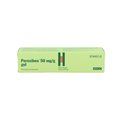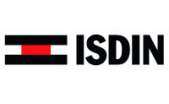Peroxiben 50 Mg/G Topical Gel 30 G
Peroxiben Gel (Benzoyl Peroxide) is a symptomatic local treatment of moderate acne vulgaris in adults and adolescents from 12 years of age.
Peroxiben Gel (Benzoyl Peroxide) is a symptomatic local treatment of moderate acne vulgaris in adults and adolescents from 12 years of age.
Peroxyben (Benzoyl Peroxide 50 Mg / G Topical Gel 30 G)
ACTION AND MECHANISM
- Antiacneic. Topical antibacterial active against Propionibacterium acnes, a microorganism involved in acne vulgaris. It is also keratolytic and antiseborrheic, counteracting hyperkeratinization and excess sebum secretion associated with acne.
PHARMACOKINETICS
The percutaneous penetration of benzoyl peroxide is low; when applied to the skin, it is completely converted to benzoic acid which is rapidly eliminated in the urine.
INDICATIONS
- [ACNE] of moderate degree.
POSOLOGY
- Adults and adolescents from 12 years: initially 1-2 applications a day on the affected area. In patients with very sensitive skin, it is advisable to start the treatment with one application a day.
It is recommended to start with the lower concentration presentations. In case of insufficient response at 3-4 weeks, the higher concentration presentations can be used.
- Children <12 years: not recommended.
Duration of treatment : improvement may be seen at 4-6 weeks, although longer periods may be necessary.
RULES FOR THE CORRECT ADMINISTRATION
- Topical gel: apply with the fingertips a thin film on the freshly washed and dry skin. Avoid the eyes, mouth, nostrils or mucous membranes. If it comes into contact with the eyes, wash immediately with lukewarm water.
It should not be applied on damaged or eczematous skin, nor on cuts or abrasions.
CONTRAINDICATIONS
- Hypersensitivity to benzoyl peroxide.
PRECAUTIONS
- Skin irritation. At the beginning of the treatment, skin irritation and peeling of the skin may appear, which usually disappears after 1-2 days after stopping the treatment. It is recommended to start the treatment in a small area of skin, and gradually increase it. In case of skin irritation, administrations should distance themselves. Stop treatment and consult a doctor if severe irritation appears, or blisters or skin edema appear.
Use caution when using cosmetics with desquamative, irritating or drying effects, as these can potentiate the irritating effects of benzoyl peroxide.
- [PHOTOSENSITIVITY REACTIONS]. Benzoyl peroxide has led to photosensitivity phenomena in skin areas exposed to the sun. It is recommended to avoid sunbathing (including UVA baths) during the treatment, and protect the skin with suitable sunscreens and / or protective clothing.
ADVICE TO THE PATIENT
- Do not apply to damaged skin, eyes, mouths or mucosa.
- Benzoyl peroxide can discolor hair or clothing.
- Do not sunbathe or UVA rays during the treatment, as you could have skin reactions as a consequence of benzoyl peroxide. Protect your skin with sunscreen or clothing.
- Notify your doctor and / or pharmacist if skin irritation or blisters or inflammation appears.
SPECIAL WARNINGS
- Assess response to treatment after 3-4 weeks. In case of insufficient response, it may be necessary to increase the concentration.
- If a reaction occurs that suggests sensitivity to any of the components, discontinue application.
- People treated with benzoyl peroxide should protect their skin from ultraviolet radiation with sunscreens adapted to their phototype and / or with protective clothing.
INTERACTIONS
No interactions have been described and due to their low absorption they are not to be expected. However, it would be advisable to avoid co-administration with azelaic acid and desquamating, irritating or drying cosmetics.
PREGNANCY
Animal safety : No data is available on the effects of benzoyl peroxide on the fetus.
Safety in humans : Adequate and well-controlled studies in humans are not available. There is extensive experience in the treatment of acne vulgaris at concentrations up to 100 mg / g, without having observed a higher incidence of fetal effects. Its administration is only accepted if there are no safer therapeutic alternatives, and the benefits outweigh the possible risks.
Effects on fertility : No specific human studies have been conducted.
LACTATION
Animal safety : no data available.
Safety in humans : it is unknown whether it is excreted in milk, and the consequences it could have for the infant. Use with caution during breastfeeding is advised. Avoid applying on the breast before breastfeeding the child.
CHILDREN
Benzoyl peroxide can be used in adolescents from 12 years of age, at the same doses as in adults. The safety and efficacy have not been evaluated in children <12 years, so it is recommended to avoid its use.
ELDERLY
There is no recommendation for use in these patients.
EFFECTS ON DRIVING
It does not present significant effects.
ADVERSE REACTIONS
Adverse reactions are usually local and disappear with discontinuation of treatment.
Adverse reactions are described according to each frequency interval, being considered very frequent (> 10%), frequent (1-10%), infrequent (0.1-1%), rare (0.01-0.1%) , very rare (<0.01%) or of unknown frequency (cannot be estimated from the available data).
- Immune system disorders: unknown frequency [HYPERSENSITIVITY REACTIONS], with [ANAPHILAXIA].
- Skin and subcutaneous tissue disorders: very common [SKIN DRYNESS], [ERITEMA], [SKIN IRRITATION], [SKIN SKIN] and burning sensation; common [PRURITE], skin pain, [IRRITATIVE CONTACT DERMATITIS]; uncommon [ALLERGIC CONTACT DERMATITIS]; unknown frequency swelling of the face, [PHOTOSENSITIVITY REACTIONS].
OVERDOSE
Symptoms : excessive skin irritation may appear. There is no experience in case of accidental or intentional ingestion.
Measures to take :
- Antidote: there is no specific antidote.
- General elimination measures: have not been established.
- Monitoring: patient monitoring does not seem accurate.
- Treatment: symptomatic, by applying emollients, cold compresses and / or preparations with topical corticosteroids.
Additional information in accordance with GPSR (EU) 2023/988:
Manufacturer: ISDIN S.A..
Address: C/ Provençals, 33, 08019 Barcelona, Spain.
Contact e-mail: [email protected].



